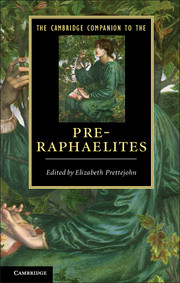Book contents
- Frontmatter
- Introduction
- PART ONE PRE-RAPHAELITISM
- PART TWO PRE-RAPHAELITES
- 6 The poetry of Dante Gabriel Rossetti (1828–1882)
- 7 The painting of Dante Gabriel Rossetti
- 8 William Holman Hunt (1827–1910)
- 9 John Everett Millais (1829–1896)
- 10 Ford Madox Brown (1821–1893)
- 11 Christina Rossetti (1830–1894)
- 12 Elizabeth Eleanor Siddall (1829–1862)
- 13 The writings of William Morris (1834–1896)
- 14 The designs of William Morris
- 15 Edward Burne-Jones (1833–1898)
- 16 Algernon Charles Swinburne (1837–1909)
- 17 William Michael Rossetti (1829–1919)
- 18 Envoi
- Appendix 1 The contents of The Germ
- Appendix 2 The Pre-Raphaelite ‘list of Immortals’
- Guide to further reading and looking
- Cambridge Companions to …
- Index
15 - Edward Burne-Jones (1833–1898)
from PART TWO - PRE-RAPHAELITES
Published online by Cambridge University Press: 28 September 2012
- Frontmatter
- Introduction
- PART ONE PRE-RAPHAELITISM
- PART TWO PRE-RAPHAELITES
- 6 The poetry of Dante Gabriel Rossetti (1828–1882)
- 7 The painting of Dante Gabriel Rossetti
- 8 William Holman Hunt (1827–1910)
- 9 John Everett Millais (1829–1896)
- 10 Ford Madox Brown (1821–1893)
- 11 Christina Rossetti (1830–1894)
- 12 Elizabeth Eleanor Siddall (1829–1862)
- 13 The writings of William Morris (1834–1896)
- 14 The designs of William Morris
- 15 Edward Burne-Jones (1833–1898)
- 16 Algernon Charles Swinburne (1837–1909)
- 17 William Michael Rossetti (1829–1919)
- 18 Envoi
- Appendix 1 The contents of The Germ
- Appendix 2 The Pre-Raphaelite ‘list of Immortals’
- Guide to further reading and looking
- Cambridge Companions to …
- Index
Summary
Edward Burne-Jones was drawn into the Pre-Raphaelite circle in the latter half of the 1850s. He and William Morris, his close friend from Exeter College, Oxford, were in awe of the charismatic Dante Gabriel Rossetti and from letters and reminiscences we gain a vivid sense of the spell cast by the attractive Rossetti with his sonorous, rolling speech patterns, intensity and urgency of manner and visionary projects. Rossetti, whose work had caught their attention, responded to the young enthusiastic Burne-Jones who tracked him down in London at a meeting of the Working Men's College. Later Burne-Jones was to describe himself in the following period as ‘clinging tight to Gabriel whom I loved, and would have been chopped up for’. The earnest valuation of friendship, the jokingly hyperbolic statement and the startling image of a wounded and dispersed self are all characteristic of Burne-Jones.
Burne-Jones started to work in pen and ink, and embarked on a painting on the theme of The Blessed Damozel, deriving from Dante Gabriel Rossetti's poem, for the Leeds-based collector Thomas Plint. He also began to design church windows for the stained-glass company Powell and Son. Along with Morris he was in 1857 invited by Rossetti to participate in a decorative scheme for the Oxford Union debating chamber and established strong bonds with the array of young artists aiming to beautify the whitewashed walls with scenes in glowing colour based on stories from a book they loved, Malory's Morte d'Arthur (1485). With the establishment of Morris, Marshall, Faulkner & Co. in 1861, Burne-Jones continued his stained-glass work, undertook tile and embroidery design and painted furniture. He was also producing graphic work in the 1860s for periodicals and for the Dalziel Brothers’ projected Illustrated Bible.
- Type
- Chapter
- Information
- The Cambridge Companion to the Pre-Raphaelites , pp. 223 - 235Publisher: Cambridge University PressPrint publication year: 2012
- 1
- Cited by

